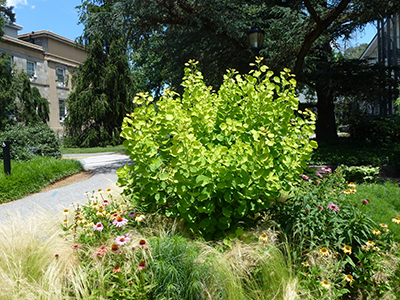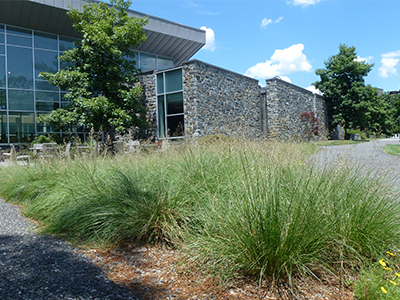Plant of the Week: July 4
Metasequoia glyptostroboides line the allée between Kolberg Hall and the Lang Performing Arts Center. As a species, the dawn redwood is over 50 million years old and was once thought to be extinct until, in the early 1940s, a small grove was located in the wilds of China. Since then the trees have been brought back and distributed around the world. They can now be found in numerous locations at the arboretum, and in Cunningham fields. These trees were not originally intended to be planted in the allée, however, due to their ability to adapt to the poor drainage and space limitations, they were installed there in the early 1990s. Since then, this small grove has firmly established itself as one of the most beautiful locations on campus. Photo Credit: Daniel Morreale
Cotinus coggygria ‘Ancot’ [Golden Spirit™] stands proud in a small bed in a corner of the Nason Garden, boasting bright, chartreuse young foliage that fades to a deep green at the base. A relatively new cultivar, derived from its deep purple cousin, this shrub is very tolerant of both poor soil and drought. Not to be outdone in the fall, the foliage color will morph to yellow, orange, and deep red. Unlike other cultivars of smoke bush, Golden Spirit™ is not known to flower. Photo Credit: Daniel Morreale
Sporobolus heterolepis
This Sporobolus heterolepis, or prairie dropseed, is found in two beds outside the Science Center. This drought-tolerant grass is deer resistant and, although it produces a multitude of seeds, it is not known to release seeds in surrounding areas. All of those attributes are fantastic for growers, especially those plagued with long, dry, hot summers, but the truly remarkable thing about the Sporobolus is its incredible smell. A heavy, sweet scent is stirred by a breeze and serves as a bright refreshing reprieve from the heat and humidity. Although this grass is understated in so many ways, with its small, nondescript seeds and simple green blades, it is not to be underestimated. Photo Credit: Daniel Morreale








No Comments